This tutorial describes how to use command line utilities to install and run hello.ftdi.44.echo.c on a basic board used in 863.13

avr-gcc command line util, etc)hello.ftdi.44.echo.chello.ftdi.44.echo.c.maketerm.pyhello.ftdi.44.echo filesmake -f hello.ftdi.44.echo.c.make$ make -f hello.ftdi.44.echo.c.make
avr-gcc -mmcu=attiny44 -Wall -Os -DF_CPU=20000000 -I./ -o hello.ftdi.44.echo.out hello.ftdi.44.echo.c
avr-objcopy -O ihex hello.ftdi.44.echo.out hello.ftdi.44.echo.c.hex;\
avr-size --mcu=attiny44 --format=avr hello.ftdi.44.echo.out
AVR Memory Usage
----------------
Device: attiny44
Program: 848 bytes (20.7% Full)
(.text + .data + .bootloader)
Data: 33 bytes (12.9% Full)
(.data + .bss + .noinit)make -f hello.ftdi.44.echo.c.make program-usbtiny$ make -f hello.ftdi.44.echo.c.make program-usbtiny
avr-objcopy -O ihex hello.ftdi.44.echo.out hello.ftdi.44.echo.c.hex;\
avr-size --mcu=attiny44 --format=avr hello.ftdi.44.echo.out
AVR Memory Usage
----------------
Device: attiny44
Program: 848 bytes (20.7% Full)
(.text + .data + .bootloader)
Data: 33 bytes (12.9% Full)
(.data + .bss + .noinit)
avrdude -p t44 -P usb -c usbtiny -U flash:w:hello.ftdi.44.echo.c.hex
avrdude: AVR device initialized and ready to accept instructions
Reading | ################################################## | 100% 0.00s
avrdude: Device signature = 0x1e9207
avrdude: NOTE: FLASH memory has been specified, an erase cycle will be performed
To disable this feature, specify the -D option.
avrdude: erasing chip
avrdude: reading input file "hello.ftdi.44.echo.c.hex"
avrdude: input file hello.ftdi.44.echo.c.hex auto detected as Intel Hex
avrdude: writing flash (848 bytes):
Writing | ################################################## | 100% 0.82s
avrdude: 848 bytes of flash written
avrdude: verifying flash memory against hello.ftdi.44.echo.c.hex:
avrdude: load data flash data from input file hello.ftdi.44.echo.c.hex:
avrdude: input file hello.ftdi.44.echo.c.hex auto detected as Intel Hex
avrdude: input file hello.ftdi.44.echo.c.hex contains 848 bytes
avrdude: reading on-chip flash data:
Reading | ################################################## | 100% 0.49s
avrdude: verifying ...
avrdude: 848 bytes of flash verified
avrdude: safemode: Fuses OK
avrdude done. Thank you.The following should open a new window. This command will vary slightly depending on your setup.
python term.py /dev/tty. (don't hit enter yet)python term.py /dev/tty.usbserial-FTGO0865 115200Irina's Page from 2011 did a great job of explaining the programming process using one of the LED blink examples.